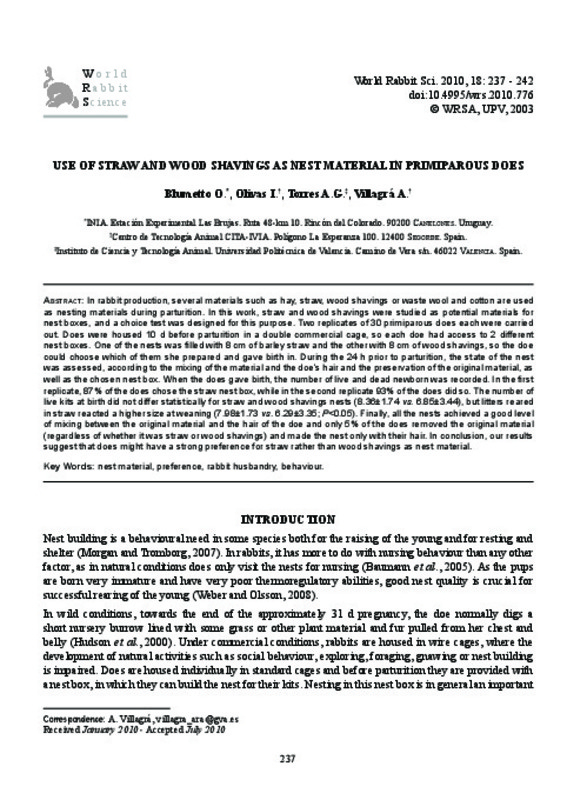JavaScript is disabled for your browser. Some features of this site may not work without it.
Buscar en RiuNet
Listar
Mi cuenta
Estadísticas
Ayuda RiuNet
Admin. UPV
Use of straw and wood shavings as nest material in primiparous does
Mostrar el registro sencillo del ítem
Ficheros en el ítem
| dc.contributor.author | Blumetto, Oscar
|
|
| dc.contributor.author | Olivas, Irene
|
|
| dc.contributor.author | Torres Salvador, Antonio Germán
|
|
| dc.contributor.author | Villagrá, Arantxa
|
|
| dc.date.accessioned | 2011-01-12T16:52:29Z | |
| dc.date.available | 2012-12-12T23:30:21Z | |
| dc.date.issued | 2010-12-30 | |
| dc.identifier.issn | 1257-5011 | |
| dc.identifier.uri | http://hdl.handle.net/10251/9145 | |
| dc.description.abstract | [EN] In rabbit production, several materials such as hay, straw, wood shavings or waste wool and cotton are used as nesting materials during parturition. In this work, straw and wood shavings were studied as potential materials for nest boxes, and a choice test was designed for this purpose. Two replicates of 30 primiparous does each were carried out. Does were housed 10 d before parturition in a double commercial cage, so each doe had access to 2 different nest boxes. One of the nests was filled with 8 cm of barley straw and the other with 8 cm of wood shavings, so the doe could choose which of them she prepared and gave birth in. During the 24 h prior to parturition, the state of the nest was assessed, according to the mixing of the material and the doe's hair and the preservation of the original material, as well as the chosen nest box. When the does gave birth, the number of live and dead newborn was recorded. In the first replicate, 87% of the does chose the straw nest box, while in the second replicate 93% of the does did so. The number of live kits at birth did not differ statistically for straw and wood shavings nests (8.36+-1.74 vs. 6.85+-3.44), but litters reared in straw reacted a higher size at weaning (7.98+-1.73 vs. 6.29+-3.35; P<0.05). Finally, all the nests achieved a good level of mixing between the original material and the hair of the doe and only 5% of the does removed the original material (regardless of whether it was straw or wood shavings) and made the nest only with their hair. In conclusion, our results suggest that does might have a strong preference for straw rather than wood shavings as nest material. | es_ES |
| dc.language | Inglés | es_ES |
| dc.publisher | World Rabbit Science. ICTA. UPV | es_ES |
| dc.relation.ispartof | World Rabbit Science | |
| dc.rights | Reserva de todos los derechos | es_ES |
| dc.subject | Nest material | es_ES |
| dc.subject | Preference | es_ES |
| dc.subject | Rabbit husbandry | es_ES |
| dc.subject | Behaviou | es_ES |
| dc.title | Use of straw and wood shavings as nest material in primiparous does | es_ES |
| dc.type | Artículo | es_ES |
| dc.identifier.doi | 10.4995/wrs.2010.776 | |
| dc.rights.accessRights | Abierto | es_ES |
| dc.contributor.affiliation | Universitat Politècnica de València. Instituto de Ciencia y Tecnología Animal - Institut de Ciència i Tecnologia Animal | es_ES |
| dc.description.bibliographicCitation | Blumetto, O.; Olivas, I.; Torres Salvador, AG.; Villagrá, A. (2010). Use of straw and wood shavings as nest material in primiparous does. World Rabbit Science. 18(4):237-242. https://doi.org/10.4995/wrs.2010.776 | es_ES |
| dc.relation.publisherversion | https://doi.org/10.4995/wrs.2010.776 | |
| dc.description.upvformatpinicio | 237 | |
| dc.description.upvformatpfin | 242 | |
| dc.description.volume | 18 | |
| dc.description.issue | 4 | |
| dc.identifier.eissn | 1989-8886 |








